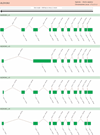The aldehyde dehydrogenase gene superfamily resource center
- PMID: 20038501
- PMCID: PMC3525204
- DOI: 10.1186/1479-7364-4-2-136
The aldehyde dehydrogenase gene superfamily resource center
Abstract
The website www.aldh.org is a publicly available database for nomenclature and functional and molecular sequence information for members of the aldehyde dehydrogenase (ALDH) gene superfamily for animals, plants, fungi and bacteria. The site has organised gene-specific records. It provides synopses of ALDH gene records, marries trivial terms to correct nomenclature and links global accession identifiers with source data. Server-side alignment software characterises the integrity of each sequence relative to the latest genomic assembly and provides identifier-specific detail reports, including a graphical presentation of the transcript's exon-intron structure, its size, coding sequence, genomic strand and locus. Also included are a summary of substrates, inhibitors and enzyme kinetics. The site provides reference lists and is designed to facilitate data mining by interested investigators.
Figures




Similar articles
-
Eukaryotic aldehyde dehydrogenase (ALDH) genes: human polymorphisms, and recommended nomenclature based on divergent evolution and chromosomal mapping.Pharmacogenetics. 1999 Aug;9(4):421-34. Pharmacogenetics. 1999. PMID: 10780262 Review.
-
Human aldehyde dehydrogenase genes: alternatively spliced transcriptional variants and their suggested nomenclature.Pharmacogenet Genomics. 2009 Nov;19(11):893-902. doi: 10.1097/FPC.0b013e3283329023. Pharmacogenet Genomics. 2009. PMID: 19823103 Free PMC article.
-
Aldehyde dehydrogenase gene superfamily: the 2000 update.Chem Biol Interact. 2001 Jan 30;130-132(1-3):323-37. doi: 10.1016/s0009-2797(00)00275-1. Chem Biol Interact. 2001. PMID: 11306055
-
Aldehyde dehydrogenase gene superfamily: the 2002 update.Chem Biol Interact. 2003 Feb 1;143-144:5-22. doi: 10.1016/s0009-2797(02)00163-1. Chem Biol Interact. 2003. PMID: 12604184
-
Single amino acid polymorphism in aldehyde dehydrogenase gene superfamily.Front Biosci (Landmark Ed). 2015 Jan 1;20(2):335-76. doi: 10.2741/4313. Front Biosci (Landmark Ed). 2015. PMID: 25553455 Review.
Cited by
-
Upregulation of ALDH1B1 promotes tumor progression in osteosarcoma.Oncotarget. 2017 Dec 20;9(2):2502-2514. doi: 10.18632/oncotarget.23506. eCollection 2018 Jan 5. Oncotarget. 2017. PMID: 29416787 Free PMC article.
-
ALDH enzyme activity is regulated by Nodal and histamine in the A549 cell line.Oncol Lett. 2017 Dec;14(6):6955-6961. doi: 10.3892/ol.2017.7057. Epub 2017 Sep 25. Oncol Lett. 2017. PMID: 29181106 Free PMC article.
-
Ectopic expression of VpALDH2B4, a novel aldehyde dehydrogenase gene from Chinese wild grapevine (Vitis pseudoreticulata), enhances resistance to mildew pathogens and salt stress in Arabidopsis.Planta. 2012 Aug;236(2):525-39. doi: 10.1007/s00425-012-1624-z. Epub 2012 Mar 23. Planta. 2012. PMID: 22437646
-
Discovery of a novel class of covalent inhibitor for aldehyde dehydrogenases.J Biol Chem. 2011 Dec 16;286(50):43486-94. doi: 10.1074/jbc.M111.293597. Epub 2011 Oct 21. J Biol Chem. 2011. PMID: 22021038 Free PMC article.
-
Update on the aldehyde dehydrogenase gene (ALDH) superfamily.Hum Genomics. 2011 May;5(4):283-303. doi: 10.1186/1479-7364-5-4-283. Hum Genomics. 2011. PMID: 21712190 Free PMC article.
References
-
- Vasiliou V, Bairoch A, Tipton KF. et al.'Eukaryotic aldehyde dehydrogenase (ALDH) genes: Human polymorphisms, and recommended nomenclature based on divergent evolution and chromosomal mapping'. Pharmacogenetics. 1999;9:421–434. - PubMed
Publication types
MeSH terms
Substances
Grants and funding
LinkOut - more resources
Full Text Sources
Other Literature Sources

